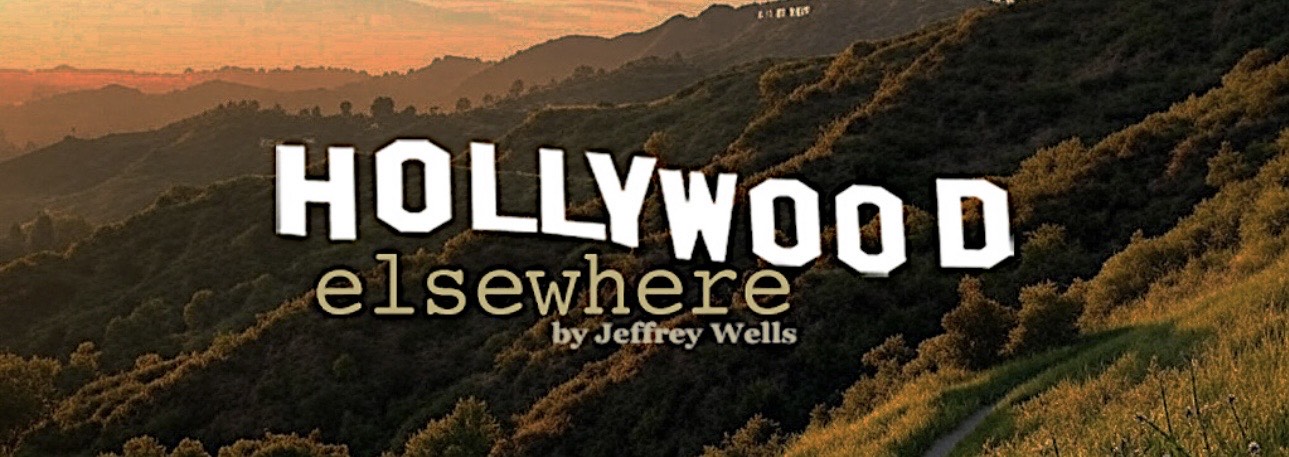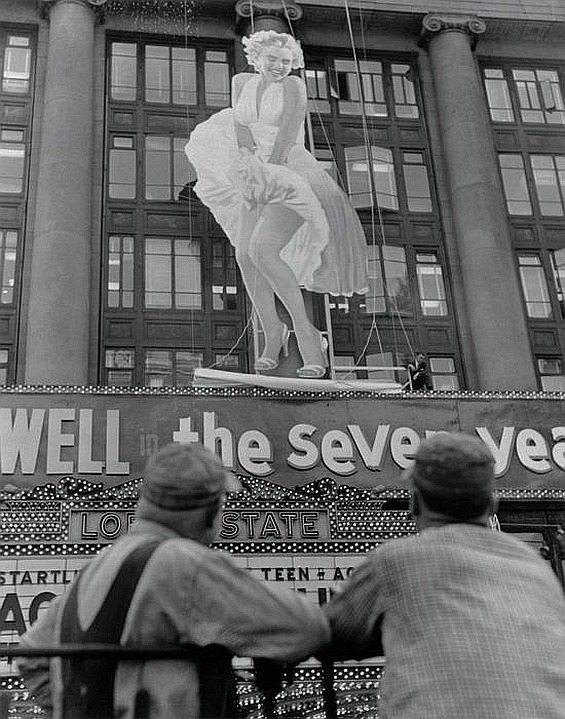 Jeff Wells
Jeff Wells
Love In The Afternoon
I’ve posted this Times Square photo before. Snapped sometime prior to the 6.3.55 opening date of The Seven Year Itch, it’s about old, working-class, overall-wearing guys regarding a super-powerful, unreachable, untouchable sexual icon…zero opportunity…their youth and vitality gone with the wind.
Itch was the second of five ’50s films directed by the once-great Billy Wilder during his house-director phase, so-called because these films represented a creative hibernation for Wilder…a retreat from his usual cynical characters and stories, acid-tinged dialogue, third-act emotional turnarounds, etc.
The house phase also included Sabrina (’54), The Spirit of St. Louis (’57), Love in the Afternoon (’57) and Witness for the Prosecution (’57). Wilder finally returned to form in ’59 with Some Like It Hot.
The house phase began in the wake of the success of Wilder’s Stalag 17 (’53). It’s been speculated it may have partly been prompted by the failure of Wilder’s bitterly caustic Ace in the Hole (’51).
Wilder called The Seven Year Itch “a nothing picture because the picture should be done today without censorship…unless Tom Ewell, left alone in New York while the wife and kid are away for the summer, has an affair with Marilyn Monroe there’s nothing. But you couldn’t do that in those days, so I was just straitjacketed. It just didn’t come off one bit, and there’s nothing I can say about it except I wish I hadn’t made it. I wish I had the property now.”
Time For Feinberg To Come Clean
What’s behind Scott Feinberg‘s bizarre insistence upon listing Tim Fehlbaum‘s September 5 as the most likely Best Picture contender of them all? It’s a good film but not top-of-the-list good. I’m not irked or angry or fuming. I’m not slapping my forehead. I just honestly don’t get it.
Funny Feeling
I’m somewhat interested in catching My Name is Alfred Hitchcock (Cohen Media Group, 10.25), a two-hour “virtual essay” fom director-writer Mark Cousins.
The reason for the “somewhat” is that I’ve been spooked by a portion of the trailer, specifically Cousins’ decision to use an image of a young, pale, rather plain-looking Asian woman early on. The instant she appeared I muttered to myself “who the hell is this, and what could she possibly have to do with the late Alfred or anything Hitchcockian or whatever?” Right away I sensed something was off, some kind of loose screw.
Kevin Maher’s London Times review, posted last July, has also given me pause.
“Any new film from the whispering cineaste and critical savant Mark Cousins is worth celebrating,” Maher wrote. “And this deep dive into the complete 52-title oeuvre of Alfred Hitchcock is worth it alone for Cousins’s analysis of the first cut in Rope, the opening doors of Spellbound and Hitch’s penchant for omniscient overhead shots.
“The central storytelling device, however, is that it’s narrated by Hitchcock (actually the impressionist Alistair McGowan) from beyond the grave. This is amusing for at least five minutes, until McGowan’s impersonation slips into a phlegmy Admiral Ackbar from Return of the Jedi and you start to crave the comforting tones that Cousins normally brings to his material.
“He has one of the most singular, soothing and mellifluous voices in non-fiction filmmaking today; that he would sacrifice that for a cheap one-note gag from Saturday night telly, beaten to death over two hours, is baffling.”
Lost in the Reeds
The inane recording studio chit-chat before the Swingin’ Blue Jeans kick into gear with “Hippy Hippy Shake“…somehow it all works better this way.
I’m genuinely embarassed to admit I have a curious soft spot for this puerile, super-synthetic tune. Originally written and recorded by 17-year-old Chan Romero in ’59. It charted at No. 3 in Australia. The Beatles recorded a crude, garage-bandy version sometime in mid’ 63. The flashier, superior Swingin’ Blue Jeans version was recorded in December ’63, and wound up charting stateside in early ’64.
“Two Years Ago She Left The Nunnery”
Where is she now?
“In Paris. She’s a member of a bizarre, sado-masochistic sexual order…whips, chains, hot candles, that sort of thing.”
Three Chris Walken scenes from Paul Mazursky‘s Next Stop, Greenwich Village. Hot candles begins at 1:18. Abortion anecdote at 2:08. Ezra Pound at 2:08.
HE interview with Sofia Coppola, discussing the excellent Somewhere (2010) but also this and that. Early on Coppola mentions my resemblance to Walken.
“If You Wouldn’t Hire A Certain Somebody To Babysit Your Kids, You Shouldn’t Let That Guy Be President of the United States”
A recent Emerson College poll, conducted between 10.14 and 10.16, has shown that among undecided voters (dumbshits, none-too-brights, slowboats) who decided on their presidential pick within the last couple of weeks, 60 percent voted for Harris while 36 percent decided in favor of Bloated Orange Fatass.
Why is this election (only two weeks left) looking like such a squeaker? Give me a sensible centrist candidate who hates wokesters and is dedicated to rolling back DEI, and I’ll vote for him/her at the drop of a hat.
But how rock stupid do you have to be to say “I think it’ll be better all around if we return the absolute worst president in U.S. history — a criminal authoritarian sociopath — to the White House”? The man is an animal, and his cult members are cool with that.
Sinatra Prime & Near-The-End Decline
Speaking of elderly singers losing their vocal game, here’s a study in Frank Sinatra contrasts — the Pal Joey version of “Bewitched“, recorded at age 41 and easily one of Sinatra’s greatest vocal performances (especially starting at the 2:30 mark), and then shoot forward to an episode that happened in ’92 when a weakened 78-year-old Sinatra, three years younger than today’s Joni Mitchell and less diminished than she seemed the other night as he was singing standing up and holding his own solo. Yes, I’ve posted this before but it’s a great story.
Nobody Touched This At First
HE to Facebook‘s Patricia Sullivan Webb about Joni Mitchell’s big show last night at the Hollywood Bowl, and more particularly the torrent of soft, gushing comments which didn’t address the reality of Mitchell’s situation:
“Why hasn’t at least one person tactfully acknowledged the plain, inescapable truth about Joni Mitchell’s singing at last night’s Hollywood Bowl?,” I wrote.
“Don’t get me wrong — I think It’s glorious that Joni performed live as best she could before an adoring throng. She obviously has the phrasing and the conviction and classic authority, and can get past some of her diminished abilities by ‘selling it’ like a pro performer. Your heart goes out.
“But her voice is gone…be honest. I’ve been listening over and over to those Asylum years tracks recently….c’mon. No comparison.
“I saw Frank Sinatra perform in Long Beach in the early ‘80s. His voice wasn’t what it had been, but he at least sounded like the Sinatra of legend.
“We all want to express love and compassion and gratitude to dear Joni, but Mitchell herself said several years ago that she can’t sing like she used to. Plus her voice is so much deeper now. I’m no professional singer but in the car or the shower I can sing just as clearly and whole-heartedly as I sang in my 20s. Mitchell can’t do that.”
Sullivan-Webb to HE: “Well, Mr. Wells, did you have a brain aneurysm which stole all your physical abilities from you? ‘Cause Joni did. And I will not judge any singer at nearly 81 to when they were in their 20s and 30s. Ny the time of Hejira, Joni’s voice after decades of smoking had deepened and she didn’t have the top notes she had in her first few albums. So what?
“Frank Sinatra performed with early dementia. That was painful to watch as he lost his place, started to re-sing songs he had just sung and struggled. He did not have his top notes but it was still by and large a Sinatra concert. Finally, his son convinced his money-grubbing stepmother to stop him from touring. She retaliated by making it very difficult for his children and grandchildren to visit him. There had to be a lawyer present. Horrific.
“Similar crap was pulled on Glen Campbell, whose 4th wife forced him to perform with full Alzheimer’s until he did not know his name and was pushed on stage to stand there as an exhausted, completely confused man who didn’t know where he was or why. He not only didn’t have his voice, he hardly had words.
“In Joni, we have a nearly 81 year old legend who is in full control of her mind and her art. Most of her show was singing jazzy songs which reflect the music she prefers and was writing and recording for 20 years prior to her massive brain injury. People can be merciless to artists as they age, gain weight, change directions. However, the 34,000 people who showed up over two nights [at the Bowl] and spent beaucoup money to see Joni, hear her, buy her merch…they were entranced.
“We are generally a mean society about stars. We dissect them, we raise them up only to discard them. Troll comments are common. Tell it to Joni Mitchell’s face. She’d look at you and laugh. Joni has a powerful intellect. Last year, she performed at The Gorge. I couldn’t get there. She played to a sold out crowd of 20,000. I first saw Joni play at The Troubadour when I was 12 or so. Perhaps there were 250 people there. I did not meet her until I was 14 — a very long time ago.
“Comparing an elderly woman’s voice to her youthful one is like comparing a beautiful 30 year old woman to what natural factors make her look like 50 years later. I see Mick Jagger, Paul McCartney and other artists in their 80s and don’t expect them to look or sound as they did 40 years ago. To expect otherwise would make me foolish, wouldn’t it? And those guys haven’t defied death by a horrific illness as Joni has. I don’t believe any artist even in their 60s can reach the same notes they could in their 20s.
“You may be deluding yourself that your vocal proficiency is the same as it was in your youth. I will assume so having been around top artists my entire life and never hearing even one of them perform with the same ease and technical proficiency as they did at the height of their success.
“Joni’s show was a masterful interpretation of her music. Her lyrics are deep and her phrasing was perfect. We are friends but even if we weren’t, I feel honored to have seen her perform as a youth, in middle age and at this juncture of her life. So much of what she wrote as a youth was written with her being a vessel, as yet, not having had many of the experiences she has now lived. ‘Both Sides Now’ sung as a woman who truly has lived life on both ends of life is far more powerful than when sung by a young woman who is imagining what life will throw at them, rather than actually experiencing the highs and lows every one of us have if we are fortunate enough to live long having gone through many kinds of hellish experiences and not coming out of it bitter and angry.”
HE to Sullivan-Webb: “Patricia — Thanks for the straight, honest and very specific response. No one had offered anything close to this when I tapped out my original comment.”
Erivo Thing Doesn’t Warrant Further Consideration
…but the Critical Drinker breaks it all down with satisfying clarity. The key moment stars at 5:35. In response to the fan poster in question, Erivo could have said nothing, gone gracious or started a shit storm. She chose the latter.
Kim Kardashian Kinda Sounds Like A Sociopath
Herewith a lesson in the moral values of Kim Kardashian. Or her convictions about moral relativity.
Kardashian basically feels that prolonged sexual abuse is as bad as murder — in her mind they basically balance or cancel each other out. She therefore believes that murder in response to prolonged sexual abuse is an understandable, perhaps even a semi-excusable response.
Kardashian therefore feels that Erik and Lyle Menendez, convicted in 1996 of the 1989 shotgun slaying of their parents, Jose and Kitty Menendez, for which the boys were sentenced to life without parole…maybe the brothers should be set free because they’ve been serving this sentence for 28 years (not to mention their many years in custody before the ’96 conviction) and…well, isn’t that enough, considering how Jose allegedly subjected Erik to acute sexual terror and blah blah?
This is more or less what Kardashian has told Variety‘s Marc Malkin and Emiliana Betancourt.
Have I explained that the sexual abuse rationale is total fucking bullshit? It is and always was.
Over a series of Vanity Fair‘ articles, Dominick Dunne certainly explained in great detail how full of shit the brothers were about this.
Kardashian to Malkin: “I think that they never got a fair second trial and I feel like ever since, for me, watching Ryan Murphy’s Monsters show it really opened up and showed me so much about abuse. Imagine if no one believed you.”
Los Angeles District Attorney George Gascon has announced that the Menendez brothers will be granted a hearing on 11.29.24 to reevaluate newly discovered evidence on their case. He has also said “they don’t deserve to be in prison until they die.”
Kardashian: “The DA’s office really should right the wrong that they did many years ago. It doesn’t mean that [the boys] shouldn’t have done time. It just means that I really believe that they deserve a second chance and they’ve done enough time.”
Friendo: “You know what would end all this Menendez bullshit sympathy? Show the photos of the dead parents. Show how they shot them to pieces with their blood and brains decorating the TV room. Show the close up of their mother’s face blown apart. They killed Kitty because if they only killed Jose they wouldn’t inherit anything. So they shot her up too. For the money — nothing else. Dunne and others pointed out where they got the “abuse” excuse from…their witchy attorney who used it before and probably afterwards. They cribbed it from a book. Plagiarism takes another bow. Fuck them.”




